#across-the-universe-91
Text

1 note
·
View note
Text
"Research on a police diversion program implemented in 2014 shows a striking 91% reduction in in-school arrests over less than 10 years.
Across the United States, arrest rates for young people under age 18 have been declining for decades. However, the proportion of youth arrests associated with school incidents has increased.
According to the U.S. Department of Education, K–12 schools referred nearly 230,000 students to law enforcement during the school year that began in 2017. These referrals and the 54,321 reported school-based arrests that same year were mostly for minor misbehavior like marijuana possession, as opposed to more serious offenses like bringing a gun to school.
School-based arrests are one part of the school-to-prison pipeline, through which students—especially Black and Latine students and those with disabilities—are pushed out of their schools and into the legal system.
Getting caught up in the legal system has been linked to negative health, social, and academic outcomes, as well as increased risk for future arrest.
Given these negative consequences, public agencies in states like Connecticut, New York, and Pennsylvania have looked for ways to arrest fewer young people in schools. Philadelphia, in particular, has pioneered a successful effort to divert youth from the legal system.
Philadelphia Police School Diversion Program
In Philadelphia, police department leaders recognized that the city’s school district was its largest source of referrals for youth arrests. To address this issue, then–Deputy Police Commissioner Kevin Bethel developed and implemented a school-based, pre-arrest diversion initiative in partnership with the school district and the city’s department of human services. The program is called the Philadelphia Police School Diversion Program, and it officially launched in May 2014.
Mayor-elect Cherelle Parker named Bethel as her new police commissioner on Nov. 22, 2023.
Since the diversion program began, when police are called to schools in the city for offenses like marijuana possession or disorderly conduct, they cannot arrest the student involved if that student has no pending court case or history of adjudication. In juvenile court, an adjudication is similar to a conviction in criminal court.
Instead of being arrested, the diverted student remains in school, and school personnel decide how to respond to their behavior. For example, they might speak with the student, schedule a meeting with a parent, or suspend the student.
A social worker from the city also contacts the student’s family to arrange a home visit, where they assess youth and family needs. Then, the social worker makes referrals to no-cost community-based services. The student and their family choose whether to attend.
Our team—the Juvenile Justice Research and Reform Lab at Drexel University—evaluated the effectiveness of the diversion program as independent researchers not affiliated with the police department or school district. We published four research articles describing various ways the diversion program affected students, schools, and costs to the city.

Arrests Dropped
In our evaluation of the diversion program’s first five years, we reported that the annual number of school-based arrests in Philadelphia decreased by 84%: from nearly 1,600 in the school year beginning in 2013 to just 251 arrests in the school year beginning in 2018.
Since then, school district data indicates the annual number of school-based arrests in Philadelphia has continued to decline—dropping to just 147 arrests in the school year that began in 2022. That’s a 91% reduction from the year before the program started.
We also investigated the number of serious behavioral incidents recorded in the school district in the program’s first five years. Those fell as well, suggesting that the diversion program effectively reduced school-based arrests without compromising school safety.
Additionally, data showed that city social workers successfully contacted the families of 74% of students diverted through the program during its first five years. Nearly 90% of these families accepted at least one referral to community-based programming, which includes services like academic support, job skill development, and behavioral health counseling...
Long-Term Outcomes
To evaluate a longer follow-up period, we compared the 427 students diverted in the program’s first year to the group of 531 students arrested before the program began. Results showed arrested students were significantly more likely to be arrested again in the following five years...
Finally, a cost-benefit analysis revealed that the program saves taxpayers millions of dollars.
Based on its success in Philadelphia, several other cities and counties across Pennsylvania have begun replicating the Police School Diversion Program. These efforts could further contribute to a nationwide movement to safely keep kids in their communities and out of the legal system."
-via Yes! Magazine, December 5, 2023
#philedelphia#pennsylvania#united states#us politics#school#high school#school to prison pipeline#prison system#arrests#education#students#schools#good news#hope#rare case of police not completely sucking#police#policing#law enforcement
1K notes
·
View notes
Text
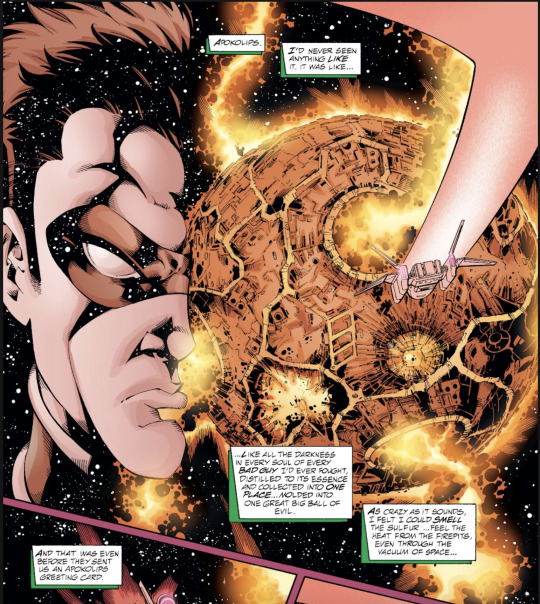
i'm not really sure what the main thrust of this post is, but this yj98 arc has been haunting me literally since I read it months ago, so I've put together a brief(ish) overview of the salient points and the questions it's left me with
aka
that time young justice was sent to a literal intergalactic war front
aka
young justice has even more complex ptsd than you probably thought!!
yj98 #35
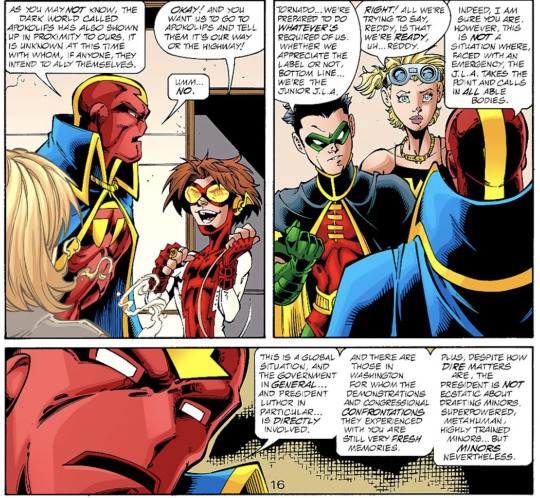
the premise is that there's a global war against imperiex, spearheaded by president (blech) luthor. as minors, they can't be drafted into it
(i hunted around and apparently Our Worlds at War, with Imperiex as the big bad, is the broader context, which i didn't feel like reading for this)

instead, they're going to be attached to a "sort of super medical unit" called the "paradocs"
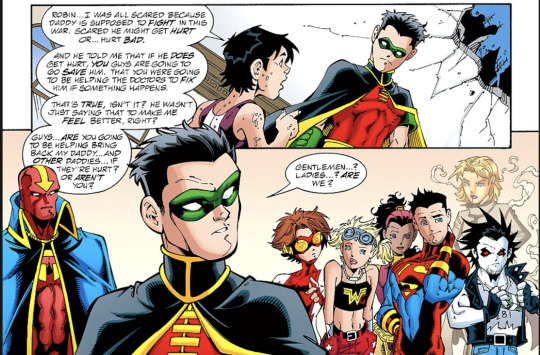
the way they're persuaded to accept their role (instead of?? fighting on the front lines?? jeez kon) is to conceive of themselves as saving active-combat superheroes for their children they're leaving at home (creating an implicit distinction between those children and themselves, which i find sad)

yj is specifically a "search and rescue team"


with a civilian cissie king-jones as their qualified emergency medical technician (so her public persona is an olympic champion, actress, and volunteer veteran of an intergalactic war???)
is cissie the only one performing medical services then? do any of the others pick anything up from her, if these missions last long enough? (do tim and cissie bond as the only non-powered people they know going into a space war?)
yj98 #36

they've run "a couple" successful missions behind enemy lines: what does this mean for the duration of this role?
(i'm not sure if reading Our Worlds at War would help determine how long this all lasted, but if someone who has read it has answers, i'd love to know)
also, were they in space the whole time or going back in between? (i also really really want to know what batman thinks of his protégé being part of a space war. related, did cassie tell her mom??)
---
Superboy Vol 4 #91: War Letters gives some context to this


(kon putting on a brave face!!)
but also:
even as paramedics they were participating in active combat, fighting off scavengers
the lack of specifics, the mention of the fact that he's met "a lot of interesting cats in the field," and of "things" he's seen—there's a sense that he's seen a lot but not enough yet for it to no longer be shocking. or, that what they're seeing is so savage that it never ceases to be shocking.
this also implies that they've met and rescued a slew of people from across the universe. does yj have intergalactic connections? do random alien soldiers remember this small group of earth children that saved them?
this panel also shows kon (and likely the rest of them) amidst recovering jl members. what does the broader jl think of this group of kids in an acknowledged war zone, seeing them beaten down like this? (it's unclear whether kon actually went and rescued kyle rayner here or is just helping him around the medical area, but there must be some sort of lasting impression from this)
they get diverged from their rescue mission and end up on apokolips

bart experiences death when one of his "scouts" is killed—this has a lasting impression on him (addressed later) and kon blames himself, since it was his decision to chase after steel that landed them here. do the two of them ever talk about this? (they don't in yj at least)
---
yj98 #36 contd.

kon's accusation shows that this arc happened right after the drama between batman and the jla during tower of babel (the secret contingency plan drama)

and after batman's betrayal of tim's identity to spoiler (rip tim being betrayed on multiple fronts)
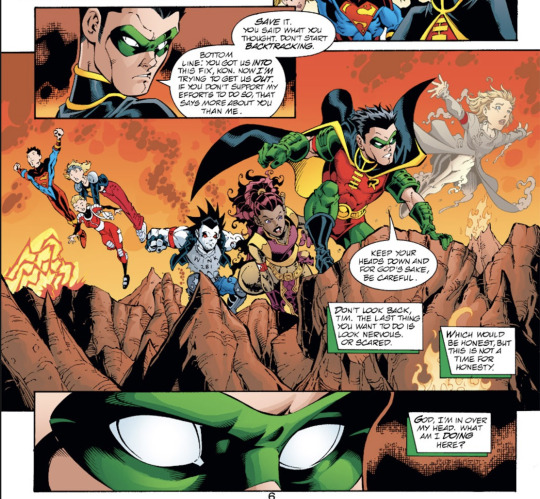
(tim putting on a strong front :'))
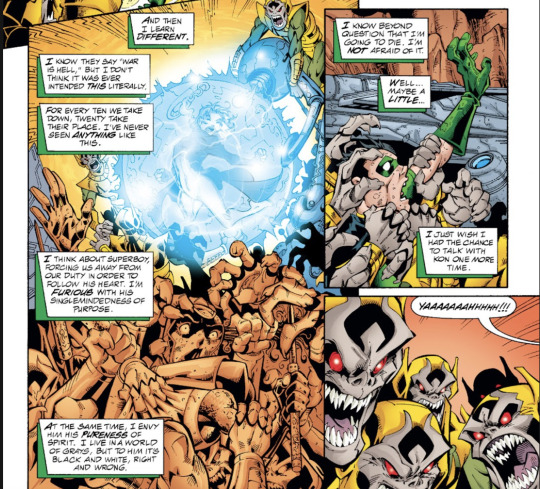
i find it interesting that tim considers his state "a world of grays" in contrast to kon's "black and white" attitude. balancing a multitude of considerations is a "world of grays?" anyway, tim staring death in the face and admitting he's scared :')

and then tim gets to watch lil lobo die (he does technically come back but!) and says explicitly that another part of innocence he didn't know he had died with lobo. this can't be his first time witnessing a death given gotham's everything, so is it because this is the first time he's watched a comrade die (and so brutally too)?
yj98 #37
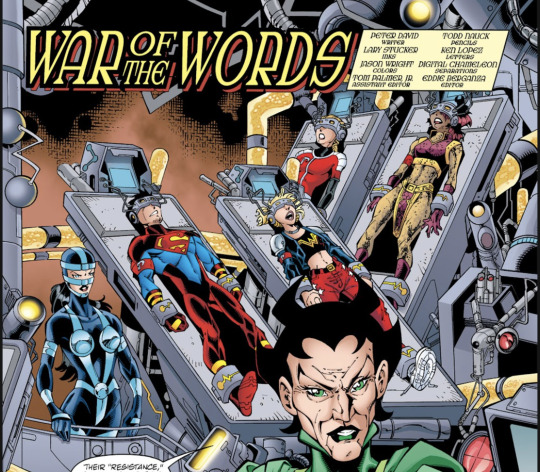
and then! we get extended(?) mental torture on apokolips, enough to drive to tim to attempted homicide (both in the dream world and out of it)

(he was made to watch kon and cassie get murdered brutally in front of him jsyk)
and once he's out:
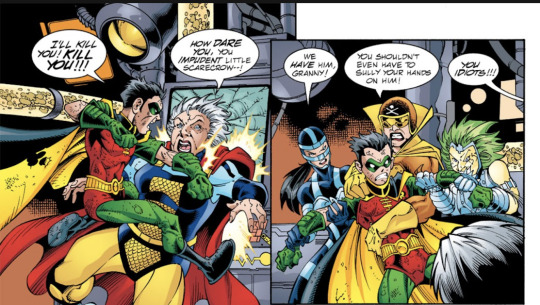
(does this ever haunt tim? that he almost broke batman's one rule? also parallels with dick beating the joker to death later on tim's behalf)
yj98 #38
the fallout:

we see that after experiencing his scout's death on apokolips, bart's been left with a fear of death strong enough to get him to leave yj (i don't actually know how this gets resolved?? it must happen in his solo bc he just sort of reappears a few mini arcs later...)
("i quit for a bunch of reasons ... but not a single one of them had to do with being afraid i'd get killed," cissie you're sooooo well-adjusted. she doesn't think bart's valid rip)

this is the moment where tim quits yj because he can't deal with their lack of trust (oof) and because“i don’t need the grief of young justice,” referring to everything else going on in tim's life (batman betraying his identity to spoiler)
(he'll lose them later on anyway—does it haunt him that he came back?)

(it's sweet that kon has someone he feels he can talk to and ask advice from)
i'm not sure if tim ever gets that apology
tldr: i kind of want one or more of yj to end up as a paramedic
#also i lied it's not brief#dc#yj#yj98#tim drake#conner kent#cissie king jones#cassie sandsmark#anita fite#greta hayes#lil lobo#red talks#also this is def biased in its focus on tim but hes my favorite what can you do
304 notes
·
View notes
Text
by Dion J. Pierre
An explosion of antisemitism at US colleges and universities since Hamas’ massacre across southern Israel on Oct. 7 is affecting how Jewish high school students choose where to pursue their post-secondary degrees, according to new survey results released by Hillel International, the world’s largest network of Jewish campus organizations.
A striking 64 percent of 427 parents of Jewish high school students surveyed by Benenson Strategy Group said their children have “crossed off” schools to which they would have applied because of concerns about antisemitism, Hillel International said on Wednesday.
Meanwhile, 80 percent of parents said concerns about safety have weighed on their child’s decision more than before Oct. 7, and 87 percent noted the atrocities by Hamas had an impact on their approach to selecting a college or university for their child.
“These findings confirm what we’ve consistently heard from Jewish parents since Oct. 7: They are alarmed by the dramatic rise in antisemitism on campus, and they and their children are changing their approach to the college decision-making process because of it,” Hillel International CEO Adam Lehman said in a press release. “As a result, parents, students, and families are turning to Hillel as the most comprehensive and reliable source of information and support for their child, and we remain committed to our work to ensure that all campuses are safe and inclusive options for all Jewish students.”
A robust Jewish life on campus may ultimately determine where Jewish students choose to enroll, the survey added. Seventy-four percent of parents said the presence of “Jewish clubs and organizations” at a school is “more important” after Oct. 7, and 91 percent said they are more likely to encourage their child to actively participate in Hillel, which operates on 850 campuses.
50 notes
·
View notes
Note
Other than leper king and his heirs which book would you recommend for research on Baldwin iv of Jerusalem?
All right then, buckle up for some nerdery! 😁
I will preface this by saying that I am not a total expert on Baldwin and haven't done a colossal amount of research specifically on him. I could chew your ear off prattling on about the general world of the crusader kingdoms, their politics, and about Raymond III of Tripoli and Sibylla of Jerusalem in particular, but Baldwin isn't my main interest here. Also, as far as I know, Hamilton's study is the only longer academic work centred solely around Baldwin. Hence, in order to learn more about your fav and the world he lived in, I'd recommend reading a little more broadly. Being a king, he is featured (at least in some capacity) in most publications that deal with the Latin kingdoms in the latter half of the 12th century.

That said, have a list:
Piers D. Mitchell: "Leprosy and the Case of King Baldwin IV of Jerusalem: Microbacterial Disease in the Crusader States of the 12th and 13th Centuries", International Journal of Leprosy, vol. 61, no. 2, 1993, pp. 283-91. Pretty self-explanatory. You can find this article on the internet; Mitchell also has a few other publications that deal with medicine in the crusader states, so you might find some additional Baldwin stuff there as well.
Elma Brenner: "Recent Perspectives on Leprosy in Medieval Western Europe", History Compass, vol. 8, no. 5, 2010, pp. 388-406. Has a little bit on Baldwin, might be useful if you want to find out more about how the disease was regarded by his contemporaries.
Helen J. Nicholson: Sybil, Queen of Jerusalem, 1186-1190. Routledge, 2022. This is a really good and really recent one that I was lucky enough to find in my uni library. Of course Sibylla-centred, but gives a good overview of the politics in Outremer and of course has passages about Baldwin in it. Also look into some of Nicholson's other publications if you're interested in the role of women in the context of crusading.
Kevin James Lewis: The Counts of Tripoli and Lebanon in the Twelfth Century: Sons of Saint Gilles. Routledge, 2017. Obviously mostly a Raymond-centric source, but it is also relatively recent and has a good chunk on Baldwin in the chapter where Lewis talks about Raymond's time as Baldwin's regent.
Joshua Prawer: Crusader Institutions. Oxford University Press, 1980. More politics to be found here, but very well put together. Prawer was an extremely prolific scholar where the history of the Latin East and the crusades was concerned, so - once again: if you're interested, look up his other works.
Jonathan Riley-Smith: The Oxford Illustrated History of the Crusades, Oxford University Press, 1997. Good overview that goes into detail about the mentality among crusaders and aspects of daily life. Again, Riley-Smith is one of the authorities in the field, so looking into his bibliography might be worth a shot.
If you're into military history, the works of Benjamin Z. Kedar, John France - or, if you want something more dated, R.C. Smail - might be of interest to you. They mostly cover general points of Frankish and Muslim warfare or the Battle of Hattin in particular (other than in Hamilton or in some of the primary sources from the crusader period, I've never come across an article on the Battle of Montgisard), but might be helpful if you want to get a feel for what life was like at the time.
Hans-Eberhard Mayer is also definitely worth a look as a scholar, even though his works are a bit older now. However, I'm not sure how much of his stuff you can find in translation - I've only read him in German.
For the physical setting of crusader-period Jerusalem and the material culture, I very heartily recommend two works written or edited by Adrian J. Boas: Jerusalem in the Time of the Crusades: Society, Landscape and Art in the Holy City under Frankish Rule (Routledge, 2001) and The Crusader World (Routledge, 2016). I consult both of these frequently for world-building in my fic writing.
If you want something on the general concept of the knight / chivalry, Maurice Keen's Chivalry (Yale University Press, 2005) might be a good start. For a detailed analysis of medieval courtly culture, I recommend Joachim Bumke's Courtly Culture: Literature and Society in the High Middle Ages (2000, English translation by Thomas Dunlap). That thing was invaluable when I was writing my BA thesis. And if you'd like to know more about the literary life of the crusaders, there is a recent publication called Literature of the Crusades (Cambridge University Press, 2019) edited by Simon Parsons and Linda M. Paterson that I also found rather good.
For fashion: The various Osprey Military History books are a good choice if you want visual representations of knightly dress. There's also a collection of essays called Encountering Medieval Textiles and Dress: Objects, Texts, Images (Palgrave Macmillan, 2002) edited by Désirée Koslin and Janet Snyder, which is one of the better ones I've found, as most books about medieval fashion focus mostly on later centuries. This one might be a bit hard to get through, though, if you don't have some kind of background knowledge about medieval texts or architecture.
If you want something less strictly academic and more in the vein of popular history, you might want to try James Reston's Warriors of God (2002) or the much more dated but rather fanboy-ish The Crusades: A History (also sometimes titled The Dream and The Tomb) by Robert Payne, which is very pro-Baldwin.
Other than that, I'll link you an older post about fictional depictions of Baldwin and other assorted good bois and girls from KoH. I hope this will scratch the Baldwin itch for you!
And: If anyone has more suggestions, of course do feel free to add them!
#asks#kingdom of heaven 2005#baldwin iv#sibylla of jerusalem#raymond iii of tripoli#balian of ibelin#crusades#snippets of actual history#book recommendations#i could add so many more books to that list lol#maybe i'll post a longer list of all the stuff i have read one day
131 notes
·
View notes
Text
o 625 words to know in your target language o
There is a really interesting blog called "Fluent Forever" that aids foreign language learners in tricks, tips and techniques to guide them to achieving fluency "quickly" and efficiently. One of the tricks is to learn these 625 vocab words in your target language, that way you have a basis to start delving into grammar with ease as you can understand a lot of vocab right off the bat. Plus this list of words are common across the world and will aid you in whatever language you are learning. Here is the list in thematic order
• Animal: dog, cat, fish, bird, cow, pig, mouse, horse, wing, animal
• Transportation: train, plane, car, truck, bicycle, bus, boat, ship, tire, gasoline, engine, (train) ticket, transportation
• Location: city, house, apartment, street/road, airport, train station, bridge hotel, restaurant, farm, court, school, office, room, town, university, club, bar, park, camp, store/shop, theater, library, hospital, church, market, country (USA,
France, etc.), building, ground, space (outer space), bank, location
• Clothing: hat, dress, suit, skirt, shirt, T-shirt, pants, shoes, pocket, coat, stain, clothing
• Color: red, green, blue (light/dark), yellow, brown, pink, orange, black, white, gray, color
• People: son, daughter, mother, father, parent (= mother/father), baby, man, woman, brother, sister, family, grandfather, grandmother, husband, wife, king, queen, president, neighbor, boy, girl, child (= boy/girl), adult (= man/woman), human (# animal), friend (Add a friend's name), victim, player, fan, crowd, person
• Job: Teacher, student, lawyer, doctor, patient, waiter, secretary, priest, police, army, soldier, artist, author, manager, reporter, actor, job
• Society: religion, heaven, hell, death, medicine, money, dollar, bill, marriage, wedding, team, race (ethnicity), sex (the act), sex (gender), murder, prison, technology, energy, war, peace, attack, election, magazine, newspaper, poison, gun, sport, race (sport), exercise, ball, game, price, contract, drug, sign, science, God
• Art. band, song, instrument (musical), music, movie, art
• Beverages: coffee, tea, wine, beer, juice, water, milk, beverage
• Food: egg, cheese, bread, soup, cake, chicken, pork, beef, apple, banana orange, lemon, corn, rice, oil, seed, knife, spoon, fork, plate, cup, breakfast, lunch, dinner, sugar, salt, bottle, food
• Home: table, chair, bed, dream, window, door, bedroom, kitchen, bathroom, pencil, pen, photograph, soap, book, page, key, paint, letter, note, wall, paper, floor, ceiling, roof, pool, lock, telephone, garden, yard, needle, bag, box, gift, card, ring, tool
• Electronics: clock, lamp, fan, cell phone, network, computer, program (computer), laptop, screen, camera, television, radio
• Body: head, neck, face, beard, hair, eye, mouth, lip, nose, tooth, ear, tear (drop), tongue, back, toe, finger, foot, hand, leg, arm, shoulder, heart, blood, brain, knee, sweat, disease, bone, voice, skin, body
• Nature: sea, ocean, river, mountain, rain, snow, tree, sun, moon, world, Earth, forest, sky, plant, wind, soil/earth, flower, valley, root, lake, star, grass, leaf, air, sand, beach, wave, fire, ice, island, hill, heat, nature
• Materials: glass, metal, plastic, wood, stone, diamond, clay, dust, gold, copper, silver, material
• Math/Measurements: meter, centimeter, kilogram, inch, foot, pound, half, circle, square, temperature, date, weight, edge, corner
• Misc Nouns: map, dot, consonant, vowel, light, sound, yes, no, piece, pain, injury, hole, image, pattern, noun, verb, adjective
• Directions: top, bottom, side, front, back, outside, inside, up, down, left, right, straight, north, south, east, west, direction
• Seasons: Summer, Spring, Winter, Fall, season
• Numbers: 0, 1, 2, 3, 4, 5, 6, 7, 8, 9, 10, 11, 12, 13, 14, 15, 16, 17, 18, 19, 20 21, 22, 30, 31, 32, 40, 41, 42, 50, 51, 52, 60, 61, 62, 70, 71, 72, 80, 81, 82, 90, 91, 92, 100, 101, 102, 110, 111, 1000, 1001, 10000, 100000, million, billion, 1st, 2nd, 3rd, 4th, 5th, number
• Months: January, February, March, April, May, June, July, August, September, October, November, December
• Days of the week: Monday, Tuesday, Wednesday, Thursday, Friday, Saturday, Sunday
• Time: year, month, week, day, hour, minute, second, morning, afternoon, evening, night, time
• Verbs: work, play, walk, run, drive, fly, swim, go, stop, follow, think, speak/say, eat, drink, kill, die, smile, laugh, cry, buy, pay, sell, shoot(a gun), learn, jump, smell, hear (a sound), listen (music), taste, touch, see (a bird), watch (TV), kiss, burn, melt, dig, explode, sit, stand, love, pass by, cut, fight, lie down, dance, sleep, wake up, sing, count, marry, pray, win, lose, mix/stir, bend, wash, cook, open, close, write, call, turn, build, teach, grow, draw, feed, catch, throw, clean, find, fall, push, pull, carry, break, wear, hang, shake, sign, beat, lift
• Adjectives: long, short (long), tall, short (vs tall), wide, narrow, big/large, small/little, slow, fast, hot, cold, warm, cool, new, old (new), young, old (young), weak, dead, alive, heavy, light (heavy), dark, light (dark), nuclear, famous
29 notes
·
View notes
Text
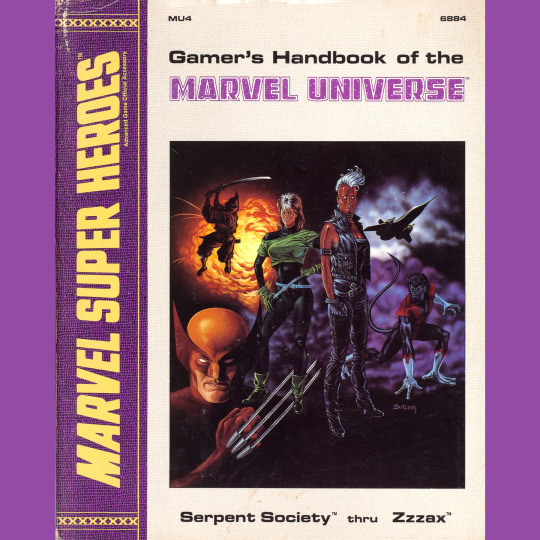




Volume four of the Gamer’s Handbook of the Marvel Universe — Serpent Society thru Zzzax (1988) is the last of the main group of books. They were followed by four annual updates ('89, ‘90, ‘91 and ‘92), which noted the major story lines, costume changes, deaths and first appearances. All told, these books amount to a clear accounting of five or six years of Marvel comic history. They’re a fascinating time capsule, given their publication on the threshold, then across that threshold, of big changes in the comic industry. But I mostly just like them because they remind me of being a kid.
X-men on the cover, which seems like a given. Wolverine was starting his trend of appearing in everything right around then. Also, punk rock Storm forever.
#RPG#TTRPG#Tabletop RPG#roleplaying game#D&D#Dungeons & Dragons#Marvel Super Heroes#Gamers Handbook to the Marvel Universe#Marvel Universe
66 notes
·
View notes
Text
Robert Reich:
Yesterday, Joe Biden spoke out against antisemitism. I’m glad he did.
But I also worry that by speaking out against antisemitism without acknowledging what has sparked the student protests across America, he is conflating those protests with antisemitism.
By and large, the protests are not motivated by antisemitism.
There may be some antisemites among demonstrators. Protest movements are often ignited by many different things and attract an assortment of people with a range of motives.
But after many talks with demonstrators and faculty, it seems clear to me this protest movement is centered on moral outrage at the killings of tens of thousands of innocent people in Gaza, most of them women and children.
Many of the demonstrators are themselves Jewish.
Jews have been involved in these protests for the same reason Jews were so involved in other social justice movements — such as the struggles for women’s rights, worker’s rights, civil rights, voting rights, free speech, and LGBTQ+ rights. And against the Vietnam War, apartheid in South Africa, and the Iraq War.
The oppression that Jewish people have experienced for hundreds if not thousands of years has taught Jews the necessity of standing up to injustice — whatever its form and whenever it appears.
Yesterday, House Republicans continued their hearings on antisemitism. They called public school officials from three of the most politically liberal communities in the nation — Berkeley, California; New York City; and Montgomery County, Maryland.
Their hearings on antisemitism in higher education helped topple the presidents of Harvard and the University of Pennsylvania and pushed Columbia’s president to promise a crackdown on campus antisemitism. Her crackdown led to the arrest of more than 100 protesters at Columbia and a further surge in student activism there.
House Republicans are politicizing and weaponizing antisemitism. They are using supposed antisemitism in education as a means of pursuing their cultural populist agenda, which for years has denigrated universities and public schools. They are also intent on splitting liberal Democrats over the war in Gaza.
[...]
I was reminded of this by the Antisemitism Awareness Act, passed in the House of Representatives on May 1, by a 320-91 vote. It would codify, for the purpose of enforcing federal civil rights law in higher education, a definition of antisemitism that includes rejection of Israel as a Jewish state. The bill also adopts the International Holocaust Remembrance Alliance’s definition of antisemitism, which includes “claims of Jews killing Jesus.”
Although the bill was initiated by House Republicans, much of the opposition to it has come from the Christian right, which wants to be able to continue saying that Jews killed Jesus.
[...]
But antisemitism can’t and shouldn’t be legislated away. Once we start defining what views are impermissible on a university campus or in public schools — for getting a job, receiving research funding, or getting promoted — we’re back in the era of Senator Joe McCarthy and communist witch hunts.
And once we start conflating antisemitism with protests against mass brutality, such as the slaughter in Gaza, we invite blindness to injustices in which America is complicit.
Robert Reich nails it in this piece about antisemitism and college campus protests.
The protests at campuses across the country are not motivated by antisemitism, but anger over Israel's genocide campaign in Gaza.
The Congressional hearings on antisemitism in colleges serve a purpose: to politicize and weaponize the definition of antisemitism and to generate anti-higher education sentiments.
#Robert Reich#Joe Biden#Campus Protests#Antisemitism#Substack#Israel/Hamas War#Ceasefire NOW Protests#Antisemitism Awareness Act#Israel Apartheid State
12 notes
·
View notes
Text
Into, Across and Beyond! Scripting: To Be or NOT to Be...?
PREVIOUS POST
In Many More Heroes, after OMT!Tails and Pana managed to bait LM!Sonic into the Quill Society meeting room, he was quickly detained by one of Zonic's rings.
Zonic: Hold it there, LM.
EV!Sonic: What's the worry?
OMT!Tails: I found this stuff in LM!Sonic's dorm you might wanna look at.
OMT!Tails passed him the files.
EV!Sonic: Way to go, little dude!
Milly: So with this, we need an explanation as to what LM's been hiding from us.
Zonic inserted the claimed disc into E-21 while LM!Sonic simply looked on.
Zonic: Right. To begin with, E-21, explain the thing.
E-21: What thing?
Zonic: What do you mean what-?! The universal-explainy thing!
E-21: Ah, right!
She activated a hologram.

(Keep in mind that this isn't all the people in the room at the time.)
The panels under the meeting room began to activate as a circle formed around them.
OMT!Tails: What is this?
Zonic: This... is everything.
The circle lit up the meeting room to show many different video clips.
OMT!Tails: Is it okay if you specify further?
Zonic: Right, sorry. The molecule-like connectors with dots around? This is all of us. All of our lives woven together, in a wonderful link to life and destiny.
OMT!Tails (in awe): The SEGAVerse...
Zonic: "SEGAVerse"? Huh, that's... not its name. It's called the Special-Extravagant-Galactic-spAce Vast Multiverse.
Everyone looked at him in confusion about it.
Zonic: ...which honestly isn't the best name I thought up, honestly.
Sunky and Tlels took notice of the nodes on the hologram between the links.
Tlels: And those nodes where those lines converge?
LM!Sonic: They're typical canon points. Chapters that are part of a hero's story quite a lot of times. Some good...
Holograms are shown of SoH!Sonic getting his super speed, the Sonic 2 opening cutscene from Sonic Origins, and SatAM Sonic and Sally sharing a kiss.
LM!Sonic: ...some bad...
Some more holograms are shown of Scorched fighting Prowler, which concerns Milly, frustrates Sunky and Tlels and confuses Blitz!Tails, a Sonic struggling to find air in Labyrinth Zone, and Archie Mina taking the bullet for her Sonic and Sally. Milly is quick to realise the implications of the third one.
Milly: ...What if I can't make it work...?
EV!Sonic: Hey, I'm sure you still can.
Zonic: And some... *sigh* REALLY bad...
Maria Robotnik's death from Project: Shadow is shown on a seventh hologram, to the horror of Movie Shadow. LM!Sonic gestured over to an eighth hologram that came in front of him as EV!Sonic kept an eye on him, ensuring he wasn't going to hide THAT one especially.
LM!Sonic: This one, Event ASM-91? A close companion to a hero dies trying to stop a personal villain of that hero.
The hologram showed footage of a younger Movie Sonic trying to go back for Longclaw, then ART sacrificing himself for Underground Sonic and his siblings to escape (which saddened UG!Sonic), and finally Mobiverse Sonic giving himself up to save Antho from Mammoth Mogul.
OMT!Tails: Did that happen to several of you guys, too...?
Sarah Henderson: In all honesty? Yeah...
D-Sides Mighty: And... what of it?
LM!Sonic: These are how the story's supposed to go.
Other holograms fly around them depicting other "canon events"; Deja vu about the Soleanna events, Shadow sacrificing his life for Sonic, and a couple of other cases.
LM!Sonic: I know EV doesn't believe what I'm saying, but canon events are the connections that bind our lives together. Yet, those connections can end up broken. It's why anomalies are so dangerous...
A hologram flashing back to OMT!Tails saving the little girl, BK!Sonic helping stop a train bound to crash, and BK!Amy rescuing Merlina from an ambush a few hours earlier.
LM!Sonic: Merlina's death was MEANT to be a canon event, and you, Tails, weren't supposed to be there or give BK time to save her! That's why Mina tried to stop you.
A flashback to the three-way rescue sequence is shown, with OMT!Mina grabbing OMT!Tails's arm doing the rush to save the kid.
Past OMT!Mina: Tails!
OMT!Tails: You what? I... I thought you were trying to save me, Mina.
OMT!Mina: I was, Tails, I... I was doing both.
LM!Sonic: And now, Prower, because you changed the story, BK!Amy's universe will most likely unravel! If we're lucky, we can stop it from happening, but we haven't always been lucky.
OMT!Tails: Hey, that wasn't me! That was Crimtake!
EV!Sonic: Yeah, like I just told you!
LM!Sonic: It's what happens when you break the canon!
EV!Sonic: Oh, boy... Here we go...
OMT!Tails: How would you know that?!
LM!Sonic: ...Because I broke it once myself, after that scumbag Eggman murdered two of my friends. I found another world where I was actually happy. At least, another variant of me was. And that version of myself was killed by Mephiles, so I replaced him.
Images are shown of LM!Sonic living a happier life in an alternate dimension, his past smile disappearing to his present-day scowl.
LM!Sonic: I thought it was harmless... but I was completely wrong.
Further images show that dimension collapsing, akin to Sonic '06's End of the World, several members of the Quill Society trying and failing to save others. LM!Sonic was running through the streets of Soleanna, Elise in his arms.
Elise: S-Sonic! Get me to the Aquatic Base! You need to put this right!
She was dying fast in LM!Sonic's arms as he raced there at top-speed.
LM!Sonic: Elise, CR? Isn't that right?
CR!Sonic: Y-Yeah...
The destruction played out in full, holographic shards flying past OMT!Tails in the aftermath.
LM!Sonic: You break enough canon, you keep doing the wrong thing... and we could end up losing it all.
The central hologram faded away as EV!Sonic and Tekno turned back.
Tekno: Look, is it really down to you breaching that world's intentions? Because it could've been another force at play!
Zonic: Honestly, I agree. Some other creep might've caused that mess just to watch you suffer.
SS!Amy: Mhm. It's like trying to claim me and my friends were "destined" to die when Finitevus erased our old home!
During this, OMT!Tails remembered from earlier.
OMT!Tails: ...Crimtake's planned target...
Crimtake: I’m going to claim what’s left of your ‘family’, Prower. Try and stop me if you can, ‘hero’!
OMT!Tails: And if Crimtake claims Cream... When does this happen?
LM!Sonic remained silent.
OMT!Tails (angered): I said WHEN DOES THIS HAPPEN?!
LM!Sonic: In 12 hours, while she's asleep.
E-21: It's... what LM!Sonic's data says.
LM!Sonic: Look, I'm sorry, kid.
OMT!Tails: I need to get moving!
SS!Amy: Yeah! I'm coming with you!
LM!Sonic: I can't let you do that, Tails. Not now.
OMT!Tails: Then what am I supposed to do?! Just let my only remaining family DIE?!
LM!Sonic just nodded as OMT!Tails turned to OMT!Mina.
OMT!Tails: What about your band? They were close to you, right?
OMT!Mina: Yeah...
OMT!Tails: And you're not gonna do anything if they end up in danger?! Okay, what about Uncle Chuck?
He looked over to CR!Sonic, who looked back wordlessly.
OMT!Tails: Would that have been okay if you knew, and you just... let a villain murder your family?!
CR!Sonic: If not for Chuck, a good handful of us wouldn't even be here, Tails.
He showed some more holograms of big portrayals of Chuck in media, the most prominent being in the aftermath of XE!Sonic leaving XE!Jules for dead.
CR!Sonic: And all the good that we did, it... It wouldn't have been done.
UG!Sonic recalled moments that his brother complained about.
UG!Manic: It's just, well... [Hits a drum] I've been thinking... everything we beat, Butt-nik rebuilds. What's the point?
Past UG!Sonic: Hey, we just munched a solid-fuel installation. That's not too shabby.
UG!Manic: Yeah, I guess. [Sighs] Seems like nothing really changes.
Manic: Yes, but my question is when? For all we know, it could happen twenty years from now. Why bother?!
Back in the present...
UG!Sonic: So what?! So... In this context LM is trying to enforce, we're just supposed to let people close to us die, just because some ALGORITHM-
E-21 (panicked): Woah, woah!

UG!Sonic: -says that's supposed to happen?! What in the world's wrong with you?!
OMT!Tails: Yeah! You three do realise how outright messed up that sounds, right?!
Zonic: *sigh* Alright, let's all take a moment here. So, think about this, in a way. You've heard HIS talk about a supposed way of doing things, right? Now, you have a choice. A choice between saving someone truly special to you, or saving a world. EVERY world if we're talking on a grander scale. Now, look, I'm not trying to force you to choose here. Nobody can. But what would you personally prioritise, if forced into it?
Almost everyone in the room: Both!
OMT!Tails: I can do BOTH of those things! A hero of Mobius always-!
CR!Sonic: Not... "always".
LM!Sonic: You can't have it all, child. Being the hero of Mobius is a sacrifice. That's the job, the job you signed up for.
Fiona: *sigh* Tails...
LM!Sonic's lot gather around OMT!Tails, with SS!Amy stepping between them.
OMT!Tails: Fiona...? What is this? Are you trying to intervene in my heroics?!
Turbo: We know it's hard, but it's still the truth, Tails.
OMT!Tails: Is that why you're gathering around me and Amy now? To let us down easy?
EV!Sonic: You lot, give them room!
OMT!Tails: It worked last time. Why not run it back, huh?
CR!Sonic: H-Hey, hold on there!
OMT!Tails (glaring at OMT!Mina): You were right, Mina. You should NEVER have gotten me involved in this brainwashed freak's game to begin with! You said yourself that you've no interest in professional work, yet that sorry excuse of a "hero" forced you to work with him anyway!
CR!Sonic: Kid, look at me.
OMT!Tails: Stop calling me that!
Pana: And here we go...
Antho: Yeah. Screw that guy.
D-Sides Mighty: Agreed.
Fiona: Pana, Antho, Mighty, you aren't helping.
Antho, Pana and D-Sides Mighty: Good.
OMT!Tails flashed a smile to those three and the kinder Quill Society members.
CR!Sonic: Please understand-!
OMT!Tails: You CAN'T ask me not to save Cream! My life is meaningless without her!
SS!Amy: Yeah! You can't ask him to play by your rules!
LM!Sonic: I'm not asking you.
LM!Sonic used an energy field to restrain OMT!Tails, which shocked everyone except for LM!Sonic's group. CR!Sonic and OMT!Mina quickly backed off seeing this, reconsidering their words.
OMT!Mina (genuinely scared for OMT!Tails): Stop that!
LM!Sonic: If I let him leave, he'll only cause MORE damage. You both know that!
CR!Sonic: No, man! This is going too far!
CR!Sonia: Yeah, you big meanie! That's enough!
CR!Manik nodded, pulling an angry raspberry at LM!Sonic. Antho, though, had a plan, using a hand gesture to remind Tails to absorb that energy from the sphere.
Antho (quietly): Like this, little dude.
LM!Sonic: We just need to hold you for a few hours! Sorry it had to end like this, kid-.
He heard the charging behind him, turning around in shock.
OMT!Tails: I said not to call me that!
Tails's vision darted around, pinning at LM!Sonic and Turbo, and triggering a blast that knocked them backwards.
UG!Sonic: Woo! Nice one, man!
Antho chuckled in approval.
D-Sides Mighty: That paid off nicely!
Milly: What do we do now?
EV!Sonic: Tails, SS, hurry over to the Transport Hub in Sector 30, and use it to bolt after Crimtake and stop him! Everyone else, be ready to cover them!
LM!Sonic got up, his temper having reached his limit.
LM!Sonic: MILES PROWER!
He leapt at the fox, with SS!Amy promptly hitting him back into the wall before he bolted off.
Antho: If he gets to that Hub first, we're in big trouble!
Tekno: Right! On your way there, Tails, send out a red alert to everyone on the planet to stop LM! And ensure he's baited over to the Terminal Velocity spot at Sector 19. That should buy you both enough distance to reach the Hub first.
OMT!Tails: Right! Come on, Amy!
SS!Amy: Right!
The two dashed off, with Turbo and Fiona in pursuit.
EV!Sonic: Everyone else, dispatch! Apprehend LM through any means necessary!
Sarah (through a communicator to Sonic.RAW): RAW? It's Sarah. I need you to get your gear ready. We've got a rogue to apprehend!
Sonic.RAW: On it right now, ma'am!
Every Quill Society member in the room headed out.
CR!Sonic: Alright.
CR!Manik: Should we help Tails out, dad?
CR!Sonic: Yeah. Sorry I'm doing this to you both... This is definitely bad parenting... Just hang tight!
CR!Sonia: You got it!
The three left.
Pana: ...And just for the record, I quit trying to bother with LM.
NEXT POST
8 notes
·
View notes
Text

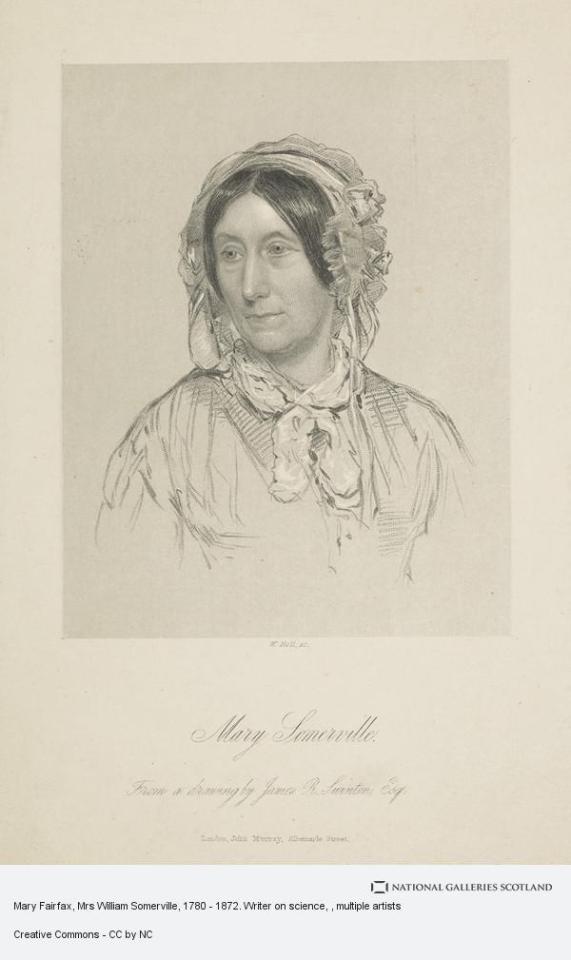

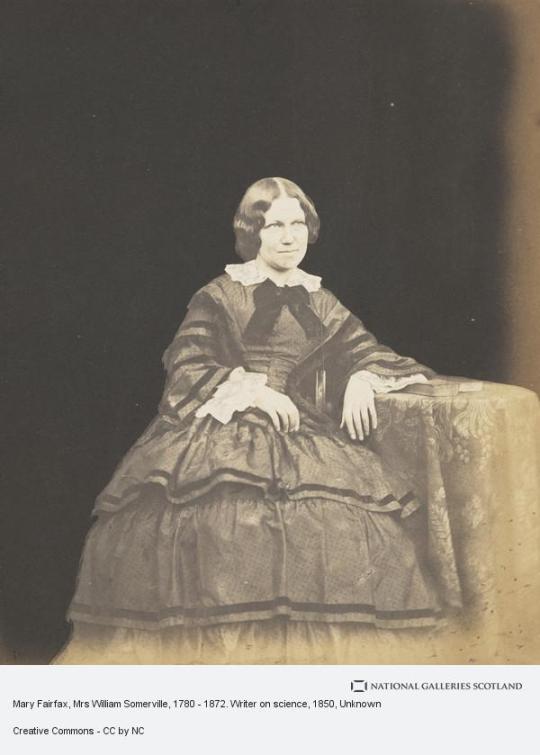
On December 26th 1780 Mathematician and scientist,Mary Somerville was born in Jedburgh.
Before Mary Sommerville came around, the word "scientist" didn't even exist!!
Born as Mary Fairfax wasrelated to several prominent Scottish houses through her mother, Margaret Charters. The family moved to Burntisland when Mary was still a child, probably due to the navy connection, her father was William George Fairfax, rose to be a Vice Admiral in the Navy.
What makes Mary's later feats all the more remarkable is that when her father returned from the sea, he discovered 8- or 9-year-old Mary could neither read nor do simple sums. By this time I assume he father had started rising through the ranks as he could afford to send her to a boarding school, Miss Primrose's School in Musselburgh.
Miss Primrose was not a good experience for Mary and she was sent home in just a year. She began to educate herself, taking music and painting lessons, instructions in handwriting and arithmetic. She learned to read French, Latin, and Greek largely on her own. At age 15, Mary noticed some algebraic formulas used as decoration in a fashion magazine, and on her own she began to study algebra to make sense of them. She surreptitiously obtained a copy of Euclid's "Elements of Geometry" over her parents' opposition. In 1804 Mary Fairfax married—under pressure from family—her cousin, Captain Samuel Greig, a Russian navy officer who lived in London. They had two sons, only one of whom survived to adulthood. Samuel also opposed Mary's studying mathematics and science, but after his death in 1807 she found herself with the opportunity and financial resources to pursue her mathematical interests.
She returned to Scotland with her surviving son and began to study astronomy and mathematics seriously. On the advice of William Wallace, a mathematics teacher at a military college, she acquired a library of books on maths and began solving math problems posed by a mathematics journal, in 1811 winning a medal for a solution she submitted.
She married Dr. William Somerville in 1812, another cousin. Somerville was the head of the army medical department in London and he warmly supported her study, writing, and contact with scientists the family moved to London in 1816 where their social circle included the leading scientific and literary lights of the day, including Babbage and the Herschel Brothers
Mary began publishing her work and was winning acclaim across Europe, so much so she was awarded a pension by the Prime Minister Robert Peel in 1834. Scottish scientist David Brewster said of her she was "certainly the most extraordinary woman in Europe - a mathematician of the very first rank with all the gentleness of a woman".
William Somerville’s health deteriorated and in 1838 the couple moved to Naples, Italy where she stayed for almost all of the remainder of her life, working and publishing.
In 1848, Mary Somerville published "Physical Geography," a book which ended up being used for 50 years in schools and universities; although at the same time, it attracted a sermon against it in York Cathedral. In 1869, Mary published yet another major work, was awarded a gold medal from the The Royal Geographical Society, and was elected to the American Philosophical Society. In 1868 aged 87 she was the first person to sign
By 1871, Mary Somerville had outlived her husbands, a daughter, and all of her sons: she wrote,
"Few of my early friends now remain—I am nearly left alone."
In 1868, four years before her death aged 91, she was the first person to sign John Stuart Mill’s unsuccessful petition arguing for women’s suffrage, in her autobiography Somerville wrote that "British laws are adverse to women".
Mary Somerville died in Naples on November 29th, 1872, just short of reaching 92.. She had been working on another mathematical article at the time and regularly read about higher algebra and solved problems each day. Her daughter published "Personal Recollections of Mary Somerville" the next year, completed mostly of before her death.
There’s a wee biography on the link below delving a bit more into Mary Sommerville’s life.
http://dangerouswomenproject.org/.../mary-somerville.../
12 notes
·
View notes
Text
It has often been dismissed as utopian thinking, a pie-in-the-sky idea that wouldn’t survive contact with reality. But the four-day week has once again quietened critics, as the results of the world’s trial suggest that it’s a win-win for employees and their bosses.
Workers who adopted a shorter week with no loss of pay were found to be happier, more productive, took fewer sick days and generated more revenue for their employers, a landmark study has found.
The Study
Led by researchers at the University of Cambridge, England, the study assessed the impact of a pioneering four-day week trial, which took place in the UK between June and December 2022. Of the 61 firms that took part – among them online retailers, financial service providers and restaurants – 56 pledged to make the move permanent. [Note: That's 91% of the firms!!]
The Results
Researchers found that 71% of participants reported lower levels of burnout, with 39% saying they were less stressed than before the trial. What’s more, 60% found that they were better able to combine paid work with care responsibilities, while 62% said it was easier to combine work with their social lives.
Unsurprisingly, this translated into a 65% reduction in sick days, and a 57% drop in the number of staff leaving compared with the same six-month period the previous year.
Concerns that switching workers to a four-day week would impact profits did not materialise. In fact, when compared to a similar period from previous years, organisations reported revenue increases of 35 per cent on average.
Trials have continually proved successful
"We feel really encouraged by the results, which showed the many ways companies were turning the four-day week from a dream into a realistic policy, with multiple benefits,�� said Dr David Frayne, research associate at University of Cambridge. “We think there is a lot here that ought to motivate other companies and industries to give it a try.”
The trial involved two months of preparation, with workshops, coaching, mentoring and peer support for participants. Resisting the idea that the trial must be ‘one-size-fits-all’, each firm designed a policy tailored to its particular needs.
Some academics have questioned the merits of a four-day week, arguing that it can create more stress for employees because they have the same amount of work to do in fewer hours.
Nevertheless, with trials taking place around the world, often with positive results, the shorter working week appears finally to be going mainstream.
Of the UK trial, Joe Ryle, director of the 4 Day Week Campaign, said: “This is a major breakthrough moment for the movement towards a four-day working week. Across a wide variety of different sectors of the economy, these incredible results show that the four-day week with no loss of pay really works.
“Surely the time has now come to begin rolling it out across the country.”
-via Positive News, 2/21/23
#four day work week#antiwork#anti work#psychology#business#workers rights#labor#capitalism#good news#hope#accessibility#workplace#work life#work life balance
336 notes
·
View notes
Text
Top 100 Best Beatles Songs warning:this is my opinion and it may not coincide with yours and this is completely normal. So please don't get mad at this list.
(I decided that it would be fair to include in this list not only songs from albums but als songs from anthologies)
100) dig it
99) free as a bird
98) three cool cats
97)my Bonnie
96) across the universe
95)yes it is
94)Anna (go to him )
93) Your Majesty
92)a taste of honey
91)money (that's what I want)
90)thing we said today
89) when I get home
88)because
87) Mr moonlight
86) no reply
85)golden slumbers
84) boys
83)sea of time
82) hey bulldog
81)dear Prudence
80)wild honey pie
79)Martha my dear
78) pigges
77)if I needed someone
76)Michelle
75)you won't see me
74) blue jay way
73) blackbird
72) yesterday
71) one after 909
70) I'm the walrus
69) strawberry fields forever
68)dig a pony
67)everybody's trying to be me baby
66) I will
65) the word
64)yer blues
63)glass onion
62) back in the U.S.S.R
61) birthday
60)happiness is a warm gun
59)why don't we do it in the road?
58)I saw her standing there
57)love me do
56) please please me
55)it won't be long
54) you really got a hold on me
53)little child
52)if I feel
51 ) I'm so happy just to dance with you
50any time at all
49) baby in black
48)hello goodbye
47) the night before
46)nowhere man
45) I'm looking trough you
44)I'm only sleeping
43) here, there and everywhere
42)good day sunshine
41)doctor Robert
40)Sgt. Pepper's Lonely Hearts Club Band
39)getting better
38) fixing a hole
37) Being For The Benefit Of Mr. Kite!
36) lovely Rita
35)only a northern song
34)yellow submarine
33) two of us
32)Maggie Mae
31)for your blue
30) she loves you
29) I want to hold your hand
28) now and then
27)maxvell's silver hammer
26)sun king
25)baby it's you
24)too much monkey business
23) young blood
22) to know her is to love her
21) I got a woman
20)get back
19) you're gonna lose that girl
18) misery
17) you're really got a hold on me
16) fool on the hill
15) good morning good morning
14) Eleanor Rigby
13) twist and shout
12)octopus's garden
11)the ballad of John and Yoko
10)oh! Darling
9) do you want to know a secret?
8)and your bird can sing
7)Lucy in the sky with diamonds
6)all you need is love
5) within you or without you
4)Norwegian wood
3) something
2) love you to
1) It's Only Love
15 notes
·
View notes
Text
Ultimate Doctor Who Poll Round 2 - Matchup 7
Episode Summaries under the cut

38: A Good Man Goes to War - Season 6, Episode 7: After Amy is kidnapped in order to steal her baby, the Doctor cashes in many favors to go after her. They are able to take back the base, discovering that because the baby was conceived in the Time Vortex, it has some Time Lord genetic material. While Amy is rescued, the baby they saved was actually a duplicate and is still with the kidnappers, who intend to use the child as a weapon to destroy the Doctor. After the fighting, River Song appears and reveals to the Doctor, Amy and Rory that she is the Ponds daughter Melody, all grown up.

91: The Halloween Apocalypse - Season 13, Episode 1: The Doctor and Yaz head to Earth after receiving a warning that it is facing it's final hours from an alien they are tracking. The alien arrives on Earth and kidnaps a man, Dan Lewis, from his home. The TARDIS lands shortly afterwards and they investigate his disappearance. They board his ship and rescue Dan, but the alien, Karvanista, reveals that his race, the Lupari, have been summoned to Earth to protect it from an incoming disaster, and that each Lupari is assigned a specific human to save.
Elsewhere several things occur. In 1820 Liverpool where Joseph Williamson is building underground tunnels. A woman is taken by a Weeping Angel. Two Sontarans speak about their mission. At a space observation post an officer sees a vast planet-destroying force spread across the universe. An old enemy of the Doctor from before her memories were stolen escapes his prison and awakens his partner.
The giant force, the Flux, approaches Earth, which the Lupari ships build a shield around. The Doctor tries to use the TARDIS to stop it, but the Flux overwhelms it and rushes inside.
#doctor who#ultimate doctor who poll#my post#polls#11th doctor#amy pond#rory williams#river song#13th doctor#yasmin khan#dan lewis#matt smith#karen gillan#arthur darvill#alex kingston#jodie whittaker#mandip gill#john bishop#a good man goes to war#the halloween apocalypse
17 notes
·
View notes
Text
🎙Today I figured I’d compile a Top 10 of my favourite Margaret interviews, with a bit (or a lot) on what I loved about each of them 🫶
Let me know whether you have any favourites that weren’t included!
1. TV Interview for Yorkshire Television Woman to Woman (02/10/85)
https(:)//youtu.be/Bzof-se9VKo?feature=shared


No notes, 10/10, golden buzzer, etc. For starters, I love love love Miriam Stoppard. The two were already acquainted due to Margaret being friends with Miriam’s husband, so that must’ve contributed to this absolute banger of an interview. She has a lovely voice, is very respectful, and extremely skilled at making Margaret open up without being intrusive. This felt less like a series of questions and more like a heart-to-heart. It chronicles her childhood, university years, marriage, and early political career, whilst providing loads of insight into the circumstances which have shaped her into who she is (the frugality of her upbringing being one of them). It’s really rare to get an extended and candid recollection of her personal life directly from the source (she herself has said that she was neither introspective nor retrospective, yet here she manages to be both) so if you don’t know much about her or have only ever consumed a one-sided narrative, I’d 100% recommend watching this.
Favourite quote: “Women always somehow, if they are left to cope, can cope. The whole world can be falling around your ears and someone will get up and carry on.”
2. TV Interview for ITN (28/06/91)
https(:)//youtu.be/L9H5nGDVfQ8?feature=shared


This was her first time opening up about her resignation - which had occurred eight months earlier over the course of a week - and I thought it was very interesting to hear her perspective on how things went down. I can't think of another occasion when she went into this much detail about it apart from the DSY memoir and the 1993 Breakfast with Frost segment. I generally like Michael Brunson and he’s one of her recurring interviewers so she must like him too. I don’t love how eager and pushy he came across at certain times here (eg: asking her to elaborate further on situations when she wanted to move on) but I think he did a solid job overall. If you're unfamiliar with the events, I'd advise you to first go watch the statement she made in Paris upon finding out she hadn't received enough votes to avoid a second ballot, then the confidence motion in the House of Commons, then her last speech outside of Downing Street, and THEN watch this interview. You'll not only have a lot more context but it also goes to show how much strain and internal struggle she was enduring, all the while appearing composed in public.
Favourite quote: “What you've done well, you're relieved about. It's a matter for relief, not for crowing."
3. TV Interview for ABC News This Week with David Brinkley (1983)
https(:)//youtu.be/wPUMEn9gJBs?feature=shared


This is literally a masterclass on how to quietly dominate and lead an interrogation while being outnumbered by your interviewers. She was being questioned about the Middle East conflicts by three men who were clearly hoping to disarm her, but she was so self-assured and unbothered that it made their sternness look silly. There's another iconic interview in the same style from her first visit to the Soviet Union but I cannot for the life of me find it without the Russian dubbing. Whoever DM's me the original version will be named in my will.
On a superficial note, I'm obsessed with how she looked in 1983 specifically. While my favourite era for her fashion is the '90s, her hair and face in 1983 were - in my opinion - at their most stunning, and this interview is the best example of that.
Favourite quote: "I'm not quite sure about the significance of your second question. It seems strangely put."
4. Life & Career of Margaret Thatcher (09/03/91)
https(:)//www.c-span.org/video/?17011-1/life-career-margaret-thatcher


This one took place during her visit to the US for the Presidential Medal of Freedom. I love Brian Lamb’s style of asking intentionally broad questions and diminishing his own presence in order to let his guests shine, something many interviewers lack the humility to do. There's a quote of his that says: "Too many interviewers try to make us think they're smarter than the person they're interviewing. I assume I'm not smarter, and if I am smarter, I don't want the audience to find out." The complete interview is 30+ minutes and he maybe talks for a total of three - as is his habit. In turn, it gives her room to speak at length with no pressure. Considering she had a reputation amongst media members for being a feisty interviewee, it's nice to see how relaxed she is when she's not feeling like she's about to be interrupted or challenged in bad faith. I imagine this would be particularly interesting to watch if you’re American because she touches on the differences between the UK and US system (in terms of the role of the monarchy, the parliamentary debates, the government's accountability to the public, etc.) If you're someone who feels strongly about her privatisation policy, I'd also advise watching this because she does go into detail as to why it was needed, especially regarding the broadcasting industry.
Favourite quote: “Some of the press who opposed me most vigorously would never have existed but for my policies of increasing liberty and getting rid of restrictive practices and enabling them to start up. But they then opposed me. So what? That's life.”
5. TV Interview for Thames TV Afternoon Plus (01/06/81)
https(:)//youtu.be/CFY6e2r2_hA?feature=shared


This was an interview that employed three different formats: the typical face-to-face questioning by the main journalist, then a pre-recorded vox pop of working-class people talking about their situation with Margaret having to comment on them, and then a live studio audience of career women there to debate her about various issues. I love this system because it showed how skilled she was at spontaneously handling any question/complaint. I think it was probably also beneficial for her to see and hear about the tangible effects of her policies in a context other than getting yelled at by protestors on the street. It was a much more productive way of connecting her with everyday people and letting their voices be heard. I also like that she talked about how difficult the task of cabinet reshuffling was (contrary to the common belief that she was sacking her ministers for sport).
Favourite quote: “If you put yourself in the front line you must expect to be shot at.”
6. TV Interview for Channel 4 A plus 4 (15/10/84)
https(:)//youtu.be/saA-gfBqpqw?feature=shared


This was her first official interview after the Brighton Bombing and I’m so admirative of her for doing this despite how traumatic it must’ve been to revisit the events. She seems eerily calm here and I don't know how much of it is shock and how much is genuine serenity but either way, she spoke very well as per usual. The interviewer seemed sweet and well suited to cover such a sensitive topic in my opinion. She also did a great job at bouncing back on replies and making the conversation flow seamlessly. They got the stuff about terrorism out of the way pretty quickly and then moved on to usual topics (mostly unemployment, and the role of business owners in creating jobs), which I felt was the best way to handle it as opposed to dragging it on for the full 30 minutes. Then she answered questions sent in from members of the public, which covered a range of stuff from her scientific background to capital punishment. Overall I like that she got to have a talk that wasn't wholly focused on the attack but also got to say what she wanted to say on it.
Favourite quote: “The sun was just coming through the stained glass windows and falling on some flowers right across the church and it just occurred to me that this was the day I was meant not to see."
7. TV Interview for BBC1 Val meets the VIPs (05/03/73)
https(:)//www.margaretthatcher.org/document/208941
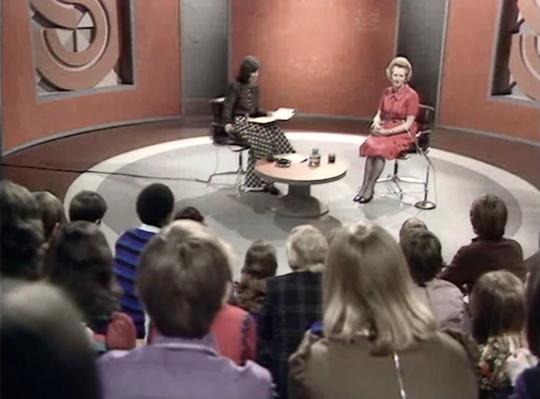

This one merges two of my favourite things: her interacting with a live audience, and her interacting with children. A lot of politicians (and adults in general) tend to take a patronising approach when talking to kids but I loved how she treated them with the same seriousness as any other interviewer, and made sure to give heartfelt, detailed replies. While the questions are naturally more basic than the likes of which she would normally receive, she does a great job at elaborating on each, and therefore I found this interview as interesting and revealing as any other. The fluidity and eloquence with which she speaks is also absolutely lovely to listen to, as is the case for all of her 1970s appearances.
Favourite quote: “Some women are very argumentative, you know, and might even win.”
8. TV Interview for Canadian TV (CBC TV) The Journal (27/09/83)
https(:)//www.cbc.ca/player/play/1662159934


Once again... 1983 my beloved. I remember being obsessed with this interview a few years ago largely because of her smudged eye makeup (intentional or not). The main theme here was national defence, and I loved her comments on why nuclear weapons were a necessary evil (she talked about that in much more detail with Robin Day in 1987 if it's something you're into). They also talked about trade unions and her attitude towards strikes. I actually quite enjoyed how argumentative the interviewer was, just enough to counter Margaret's points without coming across as stubborn. It's interesting to me that this interview is apparently iconic in Canada for being "explosive" and for the two "clearly hating each other" because I didn't get that impression at all? They obviously disagreed fundamentally but I've seen interviews where both Margaret and the journalist were much more aggressive (the Brian Walden fiasco, hello???) This one felt cold at most, but not *that* combative. Years later Barbara Amiel described the whole exchange as "rather like watching a pretty lizard mistakenly programmed to kill a mongoose" which I admit is a pretty funny way to put it, and also applicable to anyone who tries to confront Margaret 😭 (While we're here, daily mantra that Barbara Amiel is a disgrace to both journalism and womankind 🫶)
Favourite quote: “The day when this country, or any country, departs from old nostrums it will first have to decide what it’s going to put in their place.”
9. TV Interview for BBC1 My Favourite Things (07/01/87)
https(:)//www.youtube.com/watch?v=qeU_H6prrF8
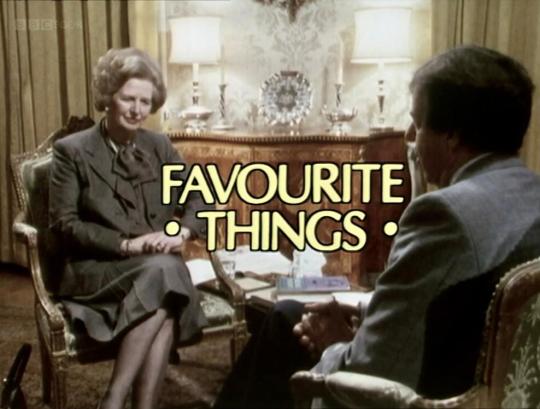

This is truly such a wholesome one, and I find the concept so unique. Basically what it says on the tin, the interview is structured around her favourite things. She'll have objects or people that she picked beforehand, and then explain why she loves them, like a little show-and-tell 🥹 It's everything from sculptures to poems to paintings, and she will tell a story about the influence that it has had on her life, and then the journalist will ask related questions to keep the interview moving. It's one of the longer ones, which is great because I love to hear her expand on topics that she personally loves. She doesn't talk about herself very often so it's so nice to hear about small things like her nightly routine or how happy doing wallpaper makes her. It's also educational to watch even if you don't particularly love or know her because she knows a lot of historical facts about people like Michael Faraday, so you'll definitely still learn things!
Favourite quote: “The Good Lord is no respecter of backgrounds. Never has been. He plants genius the world over. It is up to us to find it.”
10. KERA, a conversation with Margaret Thatcher (1991)
https(:)//youtu.be/Gbiohe_Baks?feature=shared


Finishing off with this purely for my own nostalgia because it was one of the first (if not the first) interviews of hers that I ever watched. It's not particularly special or different from the ones mentioned above but she talks a bit about the importance of a classical education (learning Latin and Greek, as well as memorising poetry) which I found pretty interesting. The interviewer was well-versed about her subject and had clearly prepared very thoroughly, which Margaret pointed out, and they seemed to get along really well.
Favourite quote: “In my case, you just had to have a star to steer by.”
#margaret thatcher#historical figures#history#uk politics#politics#interviews#ranking#journalism#top 10
3 notes
·
View notes
Text
Published: Jan 3, 2019
Researchers have developed a new way of measuring gender inequality which they argue is fairer to both men and women and presents a simplified, but more accurate, picture of people's wellbeing.
The new Basic Index of Gender Inequality (BIGI) focuses on three factors – educational opportunities, healthy life expectancy and overall life satisfaction.
Researchers from Essex and the University of Missouri used these factors to calculate BIGI scores for 134 nations, representing 6.8 billion people. Surprisingly their new measure found men are, on average, more disadvantaged than women in 91 countries compared with a relative disadvantage for women in 43 countries.
Professor Gijsbert Stoet, from the Department of Psychology at Essex, explained: “No existing measure of gender inequality fully captures the hardships that are disproportionately experienced by men in many countries and so they do not fully capture the extent to which any specific country is promoting the wellbeing of all its citizens.
“The BIGI provides a much simpler way of tackling gender inequality and it focuses on aspects of life that are directly relevant to all people. Used alongside other existing indicators, it provides additional and different information to give a more complete assessment of gender equality, making it easier for policy-makers to introduce changes to improve the quality of life for both men and women.
“We’re not saying that women in highly developed countries are not experiencing disadvantages in some aspects of their lives. What we are saying is that an ideal measure of gender equality is not biased to the disadvantages of either gender. Doing so, we find a different picture to the one commonly presented in the media.”
Until now the Global Gender Gap Index, introduced in 2006, has been one of the most established and well-used measures of national gender inequality, used by academics and policy makers across the world
But Professor Stoet argues it does not measure issues where men are at a disadvantage, such as harsher punishments for the same crime, compulsory military service and more occupational deaths. He says the complexity of the Global Gender Gap Index also means it is sometimes difficult to distinguish whether gender differences are the result of social inequalities or personal preference.
Professor David Geary, from the Department of Psychological Sciences at the University of Missouri in the United States, said: “We sought to correct the bias towards women’s issues within existing measures and at the same time develop a simple measure that is useful in any country in the world, regardless of their level of economic development.”
Using the BIGI measure, researchers found the most developed countries in the world come closest to achieving equality, albeit with a slight advantage for women. In the least developed countries, women nearly always fall behind men – largely because they have fewer opportunities to get a good education. The picture is more mixed in countries with medium-levels of development, with nearly the same number of countries where women fall behind, as countries where men fall behind. Men’s disadvantage is largely due to a shorter healthy lifespan.
Professor Stoet concluded: “Internationally improvements in gender parity may be reached by focussing on education in the least-developed nations and by focussing on preventative health care, for example in regard to abuse of drugs and alcohol, in medium and highly-developed nations.
“However, resolving gender inequality is only part of what is needed to ensure that all people can reach their full potential. Overall gender parity on its own is not sufficient, because it can simply mean that both men and women lack opportunities in different facets of life quality.”
The BIGI website: http://bigi.genderequality.info/ provides more detailed information about individual nations.
Note: the above website is no longer accessible, but a snapshot is available via archive.
Original paper:
Published: Jan 3, 2019
Abstract
The Global Gender Gap Index is one of the best-known measures of national gender inequality, used by both academics and policy makers. We argue that that this measure has a number of problems and introduce a simpler measure of national levels of gender inequality. Our proposed measure is based on sex differences in the opportunity to lead a long healthy and satisfied life that is grounded on educational opportunities. The measure better captures variation in gender inequality than other measures, with inclusion of outcomes that can be favorable or unfavorable to either sex, not simply unfavorable to women. We focus on some of the most basic measures available for 134 countries from 2012–2016 (i.e., disadvantages in children’s basic education, life satisfaction, and healthy life span) and we relate these to various measures, including the United Nations' Human Development Index. We found that low levels of human development are typically associated with disadvantages for girls and women, while medium and high levels of development are typically associated with disadvantages for boys and men. Countries with the highest levels of human development are closest to gender parity, albeit typically with a slight advantage for women. We argue that the disparities, when they are found, are related to the sexual division of labor (i.e., traditional gender roles) in poorly developed countries as well as the underinvestment in preventative health care in more developed nations.
The Global Gender Gap Index is one of the best-known measures of national gender inequality, used by both academics and policy makers. We argue that that this measure has a number of problems and introduce a simpler measure of national levels of gender inequality. Our proposed measure is based on sex differences in the opportunity to lead a long healthy and satisfied life that is grounded on educational opportunities. The measure better captures variation in gender inequality than other measures, with inclusion of outcomes that can be favorable or unfavorable to either sex, not simply unfavorable to women. We focus on some of the most basic measures available for 134 countries from 2012–2016 (i.e., disadvantages in children’s basic education, life satisfaction, and healthy life span) and we relate these to various measures, including the United Nations' Human Development Index. We found that low levels of human development are typically associated with disadvantages for girls and women, while medium and high levels of development are typically associated with disadvantages for boys and men. Countries with the highest levels of human development are closest to gender parity, albeit typically with a slight advantage for women. We argue that the disparities, when they are found, are related to the sexual division of labor (i.e., traditional gender roles) in poorly developed countries as well as the underinvestment in preventative health care in more developed nations.
Introduction
The constructs "gender equality" and "gender inequality" are frequently used in both academic research (e.g., [1–2]), in the media, and by policy makers. Therefore, it is important that researchers and policy makers have reliable measures of these constructs. We discuss some of the challenges with existing measures and introduce a conceptual approach and an associated measure that helps to resolve or at least mitigate some of theses issues.
Challenges for measuring gender inequality
Apart from political agendas, research on gender inequality has also almost exclusively focused on issues highlighted in the women's rights movement. Issues disadvantaging more men than women have been understudied (for a review, see [3]) and are not heavily weighted (if at all) in widely used measures of gender inequality, such as the highly cited Global Gender Gap Index (GGGI)[4]. Further, the GGGI truncates all values such that no country can, by definition, be more favorable for women than for men (for details see below). As a result, existing measures do not fully capture patterns of wellbeing and disadvantage at a national level. This is an important oversight, as there are issues that disproportionately affect boys and men. Among the many examples are harsher punishments for the same crimes [5] and an overrepresentation (93% worldwide) in the prison population [6]; compulsory military service (in living history or currently [3]); the large majority of homeless people without shelter are men [7]; higher levels of drug and alcohol abuse [8]; higher suicide rates [9]; more occupational deaths [10]; underperformance in schools [2]; and, men are more often victims of physical assault in general (see [3], p.30-33) and within schools, thus limiting educational opportunities [11]. Men are also overrepresented in occupations that are risky (e.g., exposure to toxins [12]) and physically taxing, such as front-line military duty, firefighting, mining, construction, or sewage cleaning.
In many countries, the retirement age is higher for men than women (although there are a few in which women's effective age of labor market exit is later, including Spain, Finland, and France), but even when it is equal, men often have fewer retirement years due to a shorter healthy life expectancy [13].
Finally, polygyny is tolerated in nearly half of all nations and is reported as being negative for women and it often is [14]; for a nuanced discussion see [15]. Polygyny, however, also means that more men than women in these nations are excluded from marriage, a family, and the opportunity to reproduce (given that polygyny leads to an unequal distribution of available partners). In other words, polygyny can be viewed as disadvantageous for most men (irrespective of the fact of whether it is disadvantageous for most women, as noted).
No existing composite measure of gender inequality fully captures the hardships that are disproportionately experienced by men and thus do not fully capture the extent to which any nation is promoting the wellbeing of all of its citizens. This is a major challenge, especially for the Global Gender Gap Index, which caps all disadvantages such that, by its definition, men can never be more disadvantaged than women. In other words, measures such as the GGGI will by design fail to measure any disadvantages experienced by boys and men.

==
"Women have always been the primary victims of war. Women lose their husbands, their fathers, their sons in combat."
-- Hillary Clinton
#gender equality#feminism#female privilege#the patriarchy#patriarchy theory#patriarchy#equality#religion is a mental illness
41 notes
·
View notes
Text
Sanjana Karanth at HuffPost:
A bill expanding the definition of antisemitism was passed on Wednesday by a bipartisan vote in the House — but despite the legislation on its face claiming to help federal officials better protect Jewish students on school campuses, critics say it is misleading and will only serve to crack down on the free speech rights of students currently protesting Israel’s ongoing military offensive in Gaza and the U.S. government’s continued support.
The House voted 320-91 in support of the Antisemitism Awareness Act, establishing a broader definition of antisemitism to enforce federal anti-discrimination laws. The bill would codify the intergovernmental International Holocaust Remembrance Alliance’s definition of antisemitism into the legal framework established by the 1964 Civil Rights Act, which bars discrimination based on shared ancestry, ethnic characteristics or national origin.
“Antisemitism is a certain perception of Jews, which may be expressed as hatred toward Jews. Rhetorical and physical manifestations of antisemitism are directed toward Jewish or non-Jewish individuals and/or their property, toward Jewish community institutions and religious facilities,” the IHRA’s working definition of antisemitism, as adopted in 2016, reads.
“Manifestations might include the targeting of the state of Israel, conceived as a Jewish collectivity,” the IHRA adds. “However, criticism of Israel similar to that leveled against any other country cannot be regarded as antisemitic.”
Seventy Democrats and 21 Republicans voted against the House bill, which now goes to the Senate. If passed and then signed into law by President Joe Biden, the bill would expand what counts as illegal ethnic discrimination to include anything covered by the IHRA’s definition of antisemitism.
[...]
The Biden administration and Congress have faced increased scrutiny from within the U.S. for their continued support of Israel’s siege in Gaza, which began after Hamas militants killed about 1,200 people on Oct. 7 in Israel and took roughly 250 hostage. The Israeli offensive has since killed more than 34,000 Palestinians in Gaza and displaced at least 80% of the region’s residents, has destroyed important infrastructure like schools, hospitals and religious institutions and has brought on a famine.
If the bill is enacted, the Department of Education could use its expanded definition of antisemitism to stifle the ongoing antiwar protests at college campuses across the U.S., according to the bill’s opponents.
In recent weeks, students from multiple faiths, races and ethnicities have begun camping out on school grounds, calling for the U.S. to stop funding Israel’s military campaign in Gaza and for their universities to divest from companies financially tied to Israel.
Witness descriptions and footage from the campus protests portray the demonstrations to be generally peaceful — though the arrival of counterprotesters and police, who have been recorded assaulting and arresting students and professors, has caused them to turn violent. Law enforcement agencies, often called in by university administrators, have so far arrested about 2,000 protesters, according to a tally by The Associated Press.
The House passed the Antisemitism Awareness Act in bipartisan fashion 320-91, with 70 Democrats and 21 Republicans voting no to the bill. The bill seeks to broaden the definition to antisemitism to match the one defined by the International Holocaust Remembrance Alliance.
The bill sounds good, but in practice, serves as a tool to suppress all legitimate criticism of Israel and their apartheid state, and to be used as a cudgel to stop student protests against Israel's genocide in Gaza on campuses nationwide.
#Antisemitism#Antisemitism Awareness Act#Israel/Hamas War#Ceasefire NOW Protests#Freedom Of Speech#International Holocaust Remembrance Alliance#Campus Protests
5 notes
·
View notes